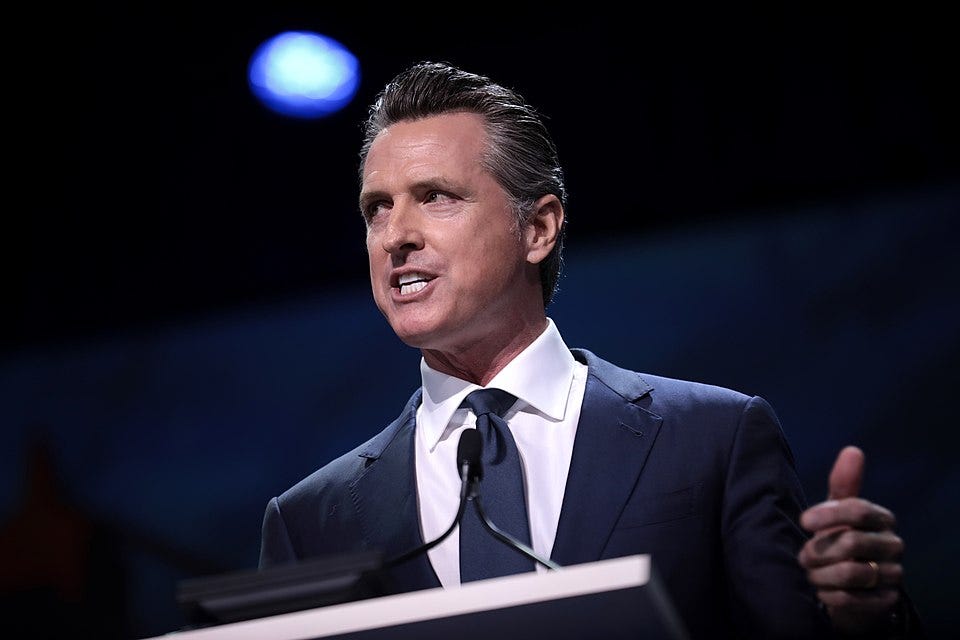Why Transgender People Are Not Feeling Gavin Newsom
We have seen this song and dance before.
If you’ve scrolled social media lately, you’ve likely seen Democrats cheering California Gov. Gavin Newsom for trolling Donald Trump. Whether it’s his all-caps posts, his red hats emblazoned with “Newsom Was Right About Everything,” or his willingness to spar with right-wing culture-war fixations like the Cracker Barrel rebrand, Newsom has been telegraphing his ambition to be Trump’s foil well before 2028. That performance has Democrats buzzing about him as a future national standard-bearer. But among transgender people, the mood is markedly different: Newsom inspires discomfort at best and outright hostility at worst. Their reaction is telling. In recent years, trans people have learned how quickly politicians can turn on them, and many see Newsom’s brand of politics as a flashing warning sign. For those who are not transgender, this piece will explain why so many of us do not look to Gavin Newsom for our future.
First, an acknowledgment: Gavin Newsom has proven effective at needling Donald Trump online. He’s gaining followers, driving news cycles, and picking fights where he knows he can land punches. On substance, he’s also taking steps Democrats should applaud—leaning hard into California’s redistricting fight after Texas’s mid-cycle power grab, and pressing California universities not to cave to Trump administration demands for monetary payments to the government and policy changes, including those for transgender people. These moves are good, or at the very least, refreshing.
But in his bid to win over the center—and even peel off some on the right—Newsom has decided that at least one group can be sacrificed for his own political gain: transgender people. In the aftermath of the 2024 election, a handful of Democratic candidates and strategists settled on a convenient scapegoat: that it was transgender rights that cost Kamala Harris the presidency. The claim is dubious—few voters ranked transgender rights as a top priority—but that hasn’t stopped would-be contenders from elevating it into a campaign plank. Centrist operatives, meanwhile, have been pushing behind the scenes to make this retreat the party’s new direction.
Newsom’s pivot came early, and it wasn’t just rhetorical. Reporting this year revealed that his office quietly worked behind the scenes to block or bury transgender protection bills in California. One measure, requiring judges in custody disputes to consider whether parents affirmed their LGBTQ+ children, was vetoed outright. Lawmakers say others were discouraged from moving forward under pressure from the governor’s office. This caution came precisely as red states were escalating their crackdowns, enacting increasingly hostile laws. California could have served as a bulwark—a safe ground—but instead, Newsom hit the brakes.
The rhetoric quickly followed. Newsom launched his podcast and began courting right-wing personalities. In one appearance with Charlie Kirk—the far-right activist whose network has poured tens of millions into anti-trans campaigns—Newsom declared he was “completely aligned” with Kirk on some transgender issues. He blamed a 2014 California law protecting transgender equality for allowing trans teens to compete while discussing a transgender runner at San Jose State University. Newsom also joined Kirk in targeting transgender incarcerated people and agreed that society must be “more sensitized” to what Kirk called the “butchery” of transgender youth—right-wing shorthand for gender-affirming care.
As we’ve seen before, rhetoric quickly translated into policy. The California Interscholastic Federation issued a new rule targeting the transgender track and field athlete who had transitioned young: she could no longer place as any other girl would. Instead, whatever place she earned would be duplicated and shared with the next-highest cisgender competitor. The results show the absurdity—records for AB Hernandez’s long jump now list two second-place winners, one cisgender and one transgender, and Hernandez was forced to share the podium. Newsom swiftly endorsed the policy, stating that he was “encouraged” by it.
And as we’ve seen before, targeting transgender people never stays confined to sports. Sports are simply the entry point—a wedge to justify broader anti-trans policy, just as they have been since the beginning of the modern debate over transgender rights. Newsom then appeared on the Shawn Ryan Show, another far-right podcast, where he expanded his rhetoric. He downplayed transgender people’s pronouns, saying, “I'm trying to understand as much as anyone else the whole ‘pronoun’ thing.” On medical care, he leaned on the Cass Review—a discredited report on transgender healthcare produced in the U.K. by advisors who also worked with Ron DeSantis to ban care in Florida. And in one of the most alarming moments, he speculated that 25 might be too early for someone to transition—a talking point straight out of the far-right’s playbook, where bans on transition until 25 are openly floated. In some places, they’re already close: Puerto Rico has banned transgender care up to age 21.
“You can’t serve the country until you’re 18, you can’t buy a gun, you can’t serve alcohol until you’re 21, and I mean to make that big of a decision as a kid,” said Shawn Ryan.
“Totally get it,” replied Newsom.
“You also could be destroying a lot of lives as well, your brain isn’t even fully developed,” continued Ryan.
“You got it, until 26, so that’s even further with the brain. Look, I come to this very much, more open minded than I’ve ever been, more receptive, because a lot of the pushback came from folks that I didn’t respect. That never respected the gay community period. People opposed to basic rights, so the natural inclination was to just dismiss. But now I recognize more fully and deeply, and I think the sports issue really opened that up for me.”
Newsom is following a pipeline transgender people have seen time and again. Transphobia rarely stays confined to one small corner; it’s almost never just a one-off statement. Those who embrace it even slightly almost always end up sliding further into opposition to nearly every facet of transgender existence. We’ve watched this radicalization play out with comedians, children’s book authors, tech billionaires, and more. It’s a pattern so well known that even anti-trans activists acknowledge it. Terry Schilling of the Republican American Principles Project once admitted as much: “The women’s sports issue was really the beginning point in helping expose all this because what it did was, it got opponents of the LGBT movement comfortable with talking about transgender issues.”
Some may argue, as they often do when transgender people raise concerns about Gavin Newsom, that the alternative would be worse. And in many respects, Trump or whatever Trump-like candidate emerges in 2028 would be worse than Newsom on a host of issues. But even here, for transgender people, the calculation is not so straightforward. Right now, the community has one thing going for it: one major political party still passes protective legislation and has not joined the litany of anti-trans policies escalating in red states. If that fragile dichotomy collapses—if Democrats too decide that transgender people can be sacrificed for political gain—the result will not be a lesser evil. It will be a political consensus that our rights are gone, and that outcome could be even worse.
One only has to look to the United Kingdom to see what happens when both major parties decide transgender people are expendable. For years, right-leaning parties targeted trans people relentlessly, while Labour offered tepid, lukewarm support. In the lead-up to recent elections, that support collapsed. Multiple Labour leaders determined that trans people were safe to sacrifice, culminating in the party leader’s now-infamous declaration that he does not believe transgender women are women. Today, the country is pursuing a nationwide bathroom ban, and youth care has been practically outlawed. In a political environment where both left and right agree that your existence is negotiable, there is no one left to fight for you. It is untenable—and if such sentiment takes root inside the Democratic Party, it could take generations for transgender Americans to claw back even the most basic of rights.
Transgender people have watched this performance before, and we know exactly where it leads. Whatever one thinks of Newsom as a politician or a future candidate, it is crucial to understand that for many in our community, his rise provokes as much fear as the Republican Party itself. The damage he can inflict is in some ways greater: Republicans attacking us keeps allies on alert, ready to resist. But when Democrats begin to adopt the same rhetoric, that resistance dissolves. Transphobia inside the party is not a treatable wound inflicted by the far right—it is a malignancy, slow-moving but devastating, one that threatens to hollow out decades of progress from within. If it spreads unchecked, it could mark the end of so much our community has fought to preserve.






I know a lot of mainline dems read my publication, so for those of you who are skeptical of my argument here because of my role as a transgender journalist, know that I _endorsed_ Kamala Harris for president. The critiques I levy against Newsom are very particular to him, and he poses a unique danger that I cannot stay silent on.
I really hope JB Pritzger (Illinois governor) picks up steam and rolls to victory in the 2028 primary. Pritzker recently started an LGBTQ+ legal hotline for residents. It's obviously aimed at helping trans and gender non-conforming folks.